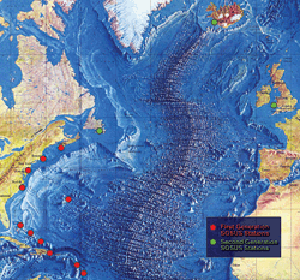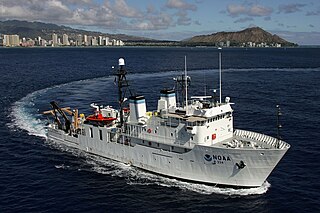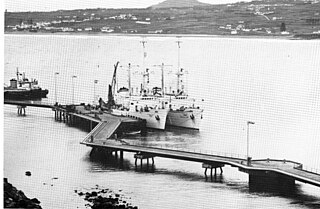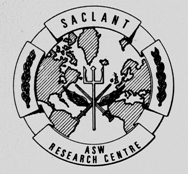
Sonar is a technique that uses sound propagation to navigate, measure distances (ranging), communicate with or detect objects on or under the surface of the water, such as other vessels.

Sound Surveillance System (SOSUS) was the original name for a submarine detection system based on passive sonar developed by the United States Navy to track Soviet submarines. The system's true nature was classified with the name and acronym SOSUS classified as well. The unclassified name Project Caesar was used to cover the installation of the system and a cover story developed regarding the shore stations, identified only as a Naval Facility (NAVFAC), being for oceanographic research. The name changed to Integrated Undersea Surveillance System (IUSS) in 1985, as the fixed bottom arrays were supplemented by the mobile Surveillance Towed Array Sensor System (SURTASS) and other new systems. The commands and personnel were covered by the "oceanographic" term until 1991 when the mission was declassified. As a result, the commands, Oceanographic System Atlantic and Oceanographic System Pacific became Undersea Surveillance Atlantic and Undersea Surveillance Pacific, and personnel were able to wear insignia reflecting the mission.

A sonobuoy is a relatively small buoy – typically 13 cm (5 in) diameter and 91 cm (3 ft) long – expendable sonar system that is dropped/ejected from aircraft or ships conducting anti-submarine warfare or underwater acoustic research.

USNS Mizar (MA-48/T-AGOR-11/T-AK-272) was a vessel of the United States Navy. She was named after the star Mizar.

USNS Stalwart (T-AGOS-1) was a Modified Tactical Auxiliary General Ocean Surveillance Ship and the lead ship of her class.

USS Glover (FF-1098) was a Garcia-class frigate originally modified for research use and commissioned as (AGDE-1) on 3 November 1965. Glover was laid down 29 July 1963 by the Bath Iron Works, in Bath, Maine and launched on 17 April 1965 with sponsors Mrs. William S. Pederson, Sr., and Mrs. Claude V. Signer, great-great-great-granddaughters of General John Glover.

USNS Vindicator (T-AGOS-3) was a United States Navy Stalwart-class modified tactical auxiliary general ocean surveillance ship that was in service from 1984 to 1993. Vindicator then served in the United States Coast Guard from 1994 to 2001 as the medium endurance cutter USCGC Vindicator (WMEC-3). From 2004 to 2020, she was in commission in the National Oceanic and Atmospheric Administration (NOAA) fleet as the oceanographic research ship NOAAS Hi'ialakai.

USNS Triumph (T-AGOS-4) is a Stalwart-class ocean surveillance ship formerly of the United States Navy. She was struck from the Naval Vessel Register in 1995. On 1 October 2012 the ship was disposed of by Navy title transfer to the Maritime Administration. As of May 2015, Triumph was held as a reserve asset for spare parts for sister ships General Rudder and State of Michigan.

USNS Indomitable (T-AGOS-7) was a United States Navy Stalwart-class ocean surveillance ship in service from 1985 to 2002. From 2003 until 18 June 2014, she was in commission in the National Oceanic and Atmospheric Administration (NOAA) as the oceanographic research ship NOAAS McArthur II. As of 2018 it serves as a mother ship now named the Deep Submersible Support Vessel (DSSV) Pressure Drop for the crewed deep-ocean research submersible DSV Limiting Factor.

USNS Titan (T-AGOS-15) was a Stalwart-class modified tactical auxiliary general ocean surveillance ship in service in the United States Navy from 1989 to 1993. From 1996 to 2014, she was in commission in the National Oceanic and Atmospheric Administration (NOAA) fleet as the oceanographic research ship NOAAS Ka'imimoana.

USNS Capable (T-AGOS-16) was a Stalwart-class modified tactical auxiliary general ocean surveillance ship of the United States Navy in service from 1989 to 2004. In 2008, she was commissioned into service in the National Oceanic and Atmospheric Administration as the oceanographic research ship NOAAS Okeanos Explorer.

USNS Relentless (T-AGOS-18) was a Stalwart-class modified tactical auxiliary general ocean surveillance ship in service in the United States Navy from 1990 to 1993. Since 1998, she has been in commission in the National Oceanic and Atmospheric Administration (NOAA) fleet as the fisheries research ship NOAAS Gordon Gunter.

Project Artemis was a United States Navy acoustics research and development experiment from the late 1950s into the mid 1960s to test a potential low-frequency active sonar system for ocean surveillance. The at sea testing began in 1960 after research and development in the late 1950s. The project's test requirement was to prove detection of a submerged submarine at 500 nmi. The experiment, covering a number of years, involved a large active element and a massive receiver array.
HMNZS Tui, formerly USNS Charles H. Davis (T-AGOR-5), was one of nine Conrad class oceanographic ships built for the United States Navy (USN), that later saw service in the Royal New Zealand Navy (RNZN). Serving with the USN from 1963 to 1970, these ships were designed to perform acoustic experiments on sound transmission underwater, and for gravity, magnetism and deep-ocean floor studies.

USNS Able (T-AGOS-20) is a Victorious-class oceanographic survey ship in the service of the United States Navy's Military Sealift Command.

USS Hunting (E-AG-398) was built as the LSM-1-class landing ship medium LSM-398 at the Charleston Navy Yard and launched in the first week of 1945. After service in the Atlantic as a landing ship the vessel was converted in 1953 to a sonar research vessel for the Naval Research Laboratory. Hunting was unique among Navy research vessels of the time in having a center well through which large towed "fish" could be transported and lowered to operating depths. The work contributed to sonar improvements and understanding ocean acoustics.

USNS Sands (T-AGOR-6) was a Robert D. Conrad-class oceanographic research ship operated by the Military Sealift Command (MSC) for the Naval Oceanographic Office from 1965 to 1973. During that period she provided ocean-bottom information and underwater test data to the U.S. Navy and other U.S. agencies. The ship was the second naval vessel to be named for Rear Admiral Benjamin F. Sands and his son Rear Admiral James H. Sands, the first being the destroyer Sands (DD-243). The ship operated in the Atlantic on oceanographic and geophysical assignments for the Oceanographic Office and other agencies.

USNS Lynch (T-AGOR-7) was a Robert D. Conrad-class oceanographic research ship that served the United States Navy from 1965 to 1994. During that period the ship was one of the ships under the technical direction of the Naval Oceanographic Office (NAVOCEANO) operating as an Auxiliary General Oceanographic Research (AGOR) program "pool" ship for support of Navy laboratories on each coast as well as NAVOCEANO projects. Lynch was assigned to support laboratories on the East Coast.

USNS Victorious (T-AGOS-19) is a Victorious-class ocean surveillance ship which was acquired by the U.S. Navy in 1991 and assigned to the Military Sealift Command (MSC) Special Missions Program.

The SACLANT ASW Research Centre was the predecessor to the NATO Undersea Research Centre. It was known as The SACLANT ASW Research Centre from 1959 through 1986, and the SACLANT Undersea Research Centre from 1987 through 2003. The centre was commonly referred to as SACLANTCEN.



















